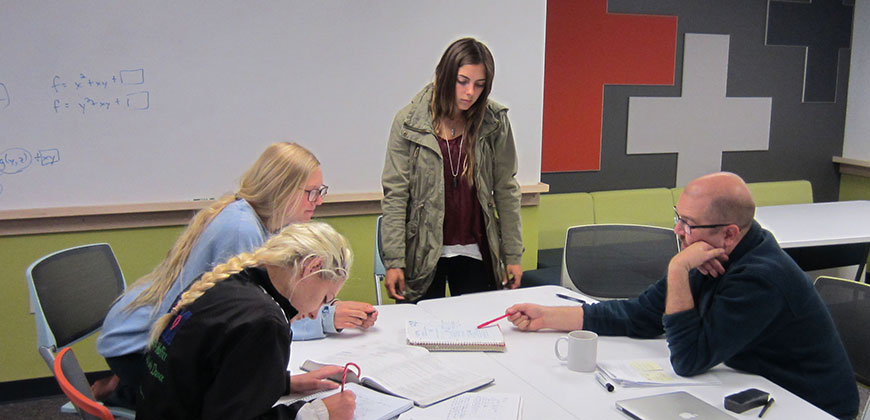
For most students, college calculus is no walk in the park. But a new center on campus is working to provide help that students can use – and to improve the way the subject is taught across disciplines.
Calculus can be an unnecessary drop-off point for students who aspire to get a degree in the STEM (science, technology, engineering, and mathematics) fields. Recent research by Colorado State University faculty members Jess Ellis and Bailey Fosdick revealed that factors such as math confidence going into college calculus – regardless of grades – can impact whether a student opts to pursue STEM studies (published in PLOS ONE).
There are many things that can help stem this STEM leak, and one of those is access to assistance outside the classroom. That’s where the new Calculus Center comes in. Open and staffed 33 hours a week, it offers tutoring, a drop-in help desk, small group mentoring sessions, and resources to the 5,000 or so CSU students who take a calculus course each year.
“With the events we have, as well as the office and help hours, we’re hoping we will provide opportunities for students to be more successful,” said mathematics Assistant Professor Mary Pilgrim, center co-director with Associate Professor Anton Betten.
Find hours and scheduling at the Calculus Center here.
The effort to shake up and improve learning at CSU has been under way in earnest for several years. Betten points to the Design Lab classroom in Aylesworth Hall, redesigned a few years ago, as one of the earliest examples of a reimagined learning space at the university. “Things are really changing on campus, and the Calculus Center is part of a trend,” Betten said. “We are now seeing a much broader base of faculty across campus willing to embrace active learning,” he said.
In 2014, College of Natural Sciences Dean Jan Nerger was curious about finding ways to improve students’ performance in these critical math courses. The upshot was a plan that received funding – in part from student facility fees – in 2015, setting the ball in motion to hire a new special assistant professor and a new associate center director (Cameron Byerley and Janet Oien, respectively) and begin renovations on the center’s space in Weber 17.
Making math better through data
Not content to simply see the center freshly painted and abuzz with students, faculty, and graduate assistants day after day, the team is already collecting data to try to make even more improvements in calculus instruction.
Collecting ID scans will allow them to track usage rates and also provide correlations with specific courses and even exam performance. “The data can help inform us about better training, about resources that students want,” Pilgrim said. The goal is not to single out individual students but to learn from what is happening naturally. The big question, she said, is: “How can we work together” to improve the calculus experience?
In just its first month, the center has proved quite popular. In fact, the sessions for some classes spill over from Weber 17 to TILT and elsewhere on campus to accommodate the large number of students. Eventually, the center’s directors hope to ramp up offerings even more. “We’d like to hold more workshops for faculty for sure,” Pilgrim said.
Already, Pilgrim continued, more than 350 students have used the Calculus Center in its first month of operation. And she and the team hope that trend continues. After all, for so many fields of study, calculus is integral.